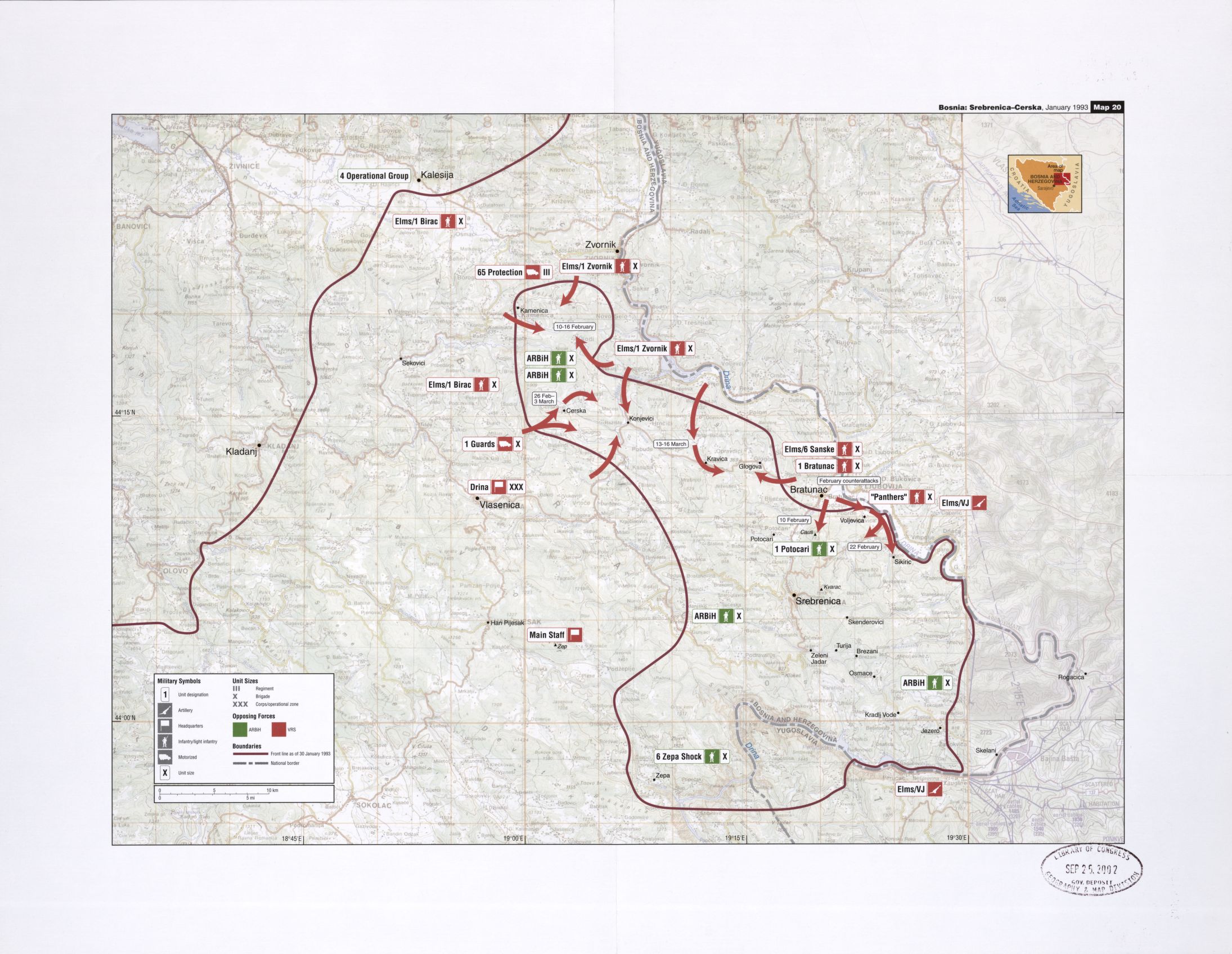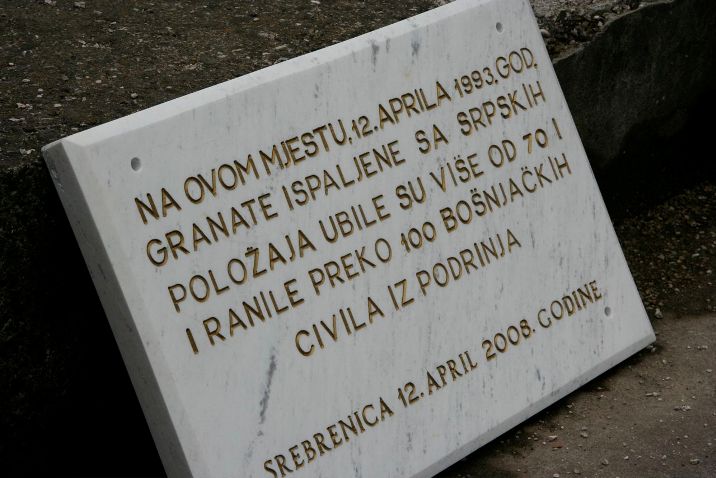12 April 1993 Srebrenica Shelling on:
[Wikipedia]
[Google]
[Amazon]
On 12 April 1993, the Army of Republika Srpska (VRS) launched an artillery attack against the town of Srebrenica, in eastern Bosnia, which left 56 dead and 73 seriously wounded, among whom were 14 children dead in a school playground. The attack came following the suspension of cease-fire talks, hours before NATO would implement a no-fly zone according to an UN resolution. VRS officials had previously told UNHCR representatives that the VRS would shell the town within two days unless it surrendered.
 Srebrenica was a Bosnian Muslim (
Srebrenica was a Bosnian Muslim (
 On 16 April, the UN declared Srebrenica a
On 16 April, the UN declared Srebrenica a
"'94 WINTER OLYMPICS / Lillehammer: Few Know Troubles He's Seen"
'' Los Angeles Times'', 27 February 1994 After seeing him on CNN, a wealthy Croatian-American couple paid for his location and evacuation. The incident is included in the 26th point ("Shelling of civilian gatherings") in the initial indictment issued by the ICTY on 24 July 1995 against Bosnian Serb leaders Radovan Karadžić and Ratko Mladić. 15 civilian casualties at the Srebrenica playground are listed. The incident is also mentioned in
Background
 Srebrenica was a Bosnian Muslim (
Srebrenica was a Bosnian Muslim (Bosniak
The Bosniaks ( bs, Bošnjaci, Cyrillic: Бошњаци, ; , ) are a South Slavic ethnic group native to the Southeast European historical region of Bosnia, which is today part of Bosnia and Herzegovina, who share a common Bosnian ancestry, cu ...
) enclave
An enclave is a territory (or a small territory apart of a larger one) that is entirely surrounded by the territory of one other state or entity. Enclaves may also exist within territorial waters. ''Enclave'' is sometimes used improperly to deno ...
. It was in a vulnerable location, easily targeted by artillery. VRS overran the town in April 1992, and it was then recaptured by Muslim irregulars in May. It was a starting point of Muslim guerrilla activity against Serb settlements in the eastern part of Bosnia during the 1992–93 winter. Muslim raids on Serb settlements enraged the VRS, inviting for revenge attacks. Bosnian Muslim forces attacked Kravica, a Serb village, in January 1993. The VRS responded with a counter-offensive, capturing Konjević Polje
Konjević Polje ( sr-cyrl, Коњевић Поље) is a village in the municipality of Bratunac, in the Drina Valley of northeastern Bosnia and Herzegovina. It practically merged with neighboring village ''Konjevići''.
Bosnian War
During the ...
and Cerska, severing the Srebrenica– Žepa link and reducing the size of the Srebrenica enclave to 150 km2. Thousands of Muslim refugees, cleansed from surrounding settlements, had flocked to the town, sleeping in the open. The population swelled to 50–60,000. The VRS blockaded aid convoys from entering the town. There were reports of terror inflicted by both sides in the months following January.
UNPROFOR commander Philippe Morillon had on 12 March 1993 promised the town residents that they were under UN protection and that he would 'never abandon' them. This move angered his superiors, but made him a hero in Srebrenica. He had been held hostage by the Muslim citizens until he promised to bring security. The residents lived under siege conditions. Between March and April, 8–9,000 Bosnian Muslims were evacuated from the town by the UNHCR. The evacuations were opposed by the Bosnian Muslim government as they contributed to the "ethnic cleansing" of the territory.
At the beginning of April 1993, the Bosnian Serbs ordered through UNHCR the surrender of the Bosnian government within 48 hours. They required that the UN forces assist the VRS (headed by Ratko Mladić) by evacuating and disarming over 60,000 people in the enclave.
Shelling
On 12 April 1993 a VRS artillery attack of two short bombardments on Srebrenica left 56 dead, including children, and 73 seriously wounded. Shells dropped on the densely packed streets of the town. 14 bodies of children were found in a school playground (soccer field), which had been hit by a shell at around 3 PM according to HRW. There was a total of 15 civilian casualties at the playground according to the ICTY. The attack came after suspension of cease-fire talks, hours before NATO would implement a no-fly zone according to UNSCR 781. The VRS had earlier told UNHCR representatives that they would attack the town of Srebrenica within two days unless it surrendered. The Bosnian Serb suspension of talks and shelling of the town 'seemed a deliberate act of malice and political intent'. UN first reported that the shelling was a response to a Muslim attack, but later retracted the statement since there were no evidence for a Muslim aggression. The UNPROFOR's handling has been criticized as ineffective.Witness accounts
American journalist Chuck Sudetic interviewed Bosnian Army doctor Nedret Mujkanović who claimed 36 people dead on site and 102 seriously wounded at the playground, whom he treated. "People were sitting around in front of the school," he said. "The children were playing football and other games. In less than one minute, seven rockets from a multiple-rocket launcher fell in an area about half the size of a football field." He claimed that the VRS knew that there was a refugee camp at the school and that they directed their fire at that location.Aftermath and legacy
 On 16 April, the UN declared Srebrenica a
On 16 April, the UN declared Srebrenica a safe zone
The term safe space refers to places "intended to be free of bias, conflict, criticism, or potentially threatening actions, ideas, or conversations". The term originated in LGBT culture, but has since expanded to include any place where a marg ...
, and also put the enclaves of Žepa and Goražde
Goražde ( cyrl, Горажде, ) is a city and the administrative center of Bosnian-Podrinje Canton Goražde of the Federation of Bosnia and Herzegovina, an entity of Bosnia and Herzegovina. It is situated on the banks of Drina river. As of 2 ...
under UN protection.
A photograph of a blood-covered and blinded boy lying on a stretcher, Sead Bekrić, was widely broadcast and made the front cover of '' Newsweek''. The word "Bosnia" was printed across Sead's injured chest.Mike Downey"'94 WINTER OLYMPICS / Lillehammer: Few Know Troubles He's Seen"
'' Los Angeles Times'', 27 February 1994 After seeing him on CNN, a wealthy Croatian-American couple paid for his location and evacuation. The incident is included in the 26th point ("Shelling of civilian gatherings") in the initial indictment issued by the ICTY on 24 July 1995 against Bosnian Serb leaders Radovan Karadžić and Ratko Mladić. 15 civilian casualties at the Srebrenica playground are listed. The incident is also mentioned in
Emir Suljagić
Emir Suljagić (born 21 May 1975) is a Bosnian journalist and politician who is currently the Director of the Srebrenica Genocide Memorial. He served as Minister of Education of Sarajevo Canton from 13 January 2011 until 29 February 2012 and was ...
's personal account of the siege and fall of Srebrenica, ''Postcards from the Grave
''Postcards from the Grave'' is a book by Emir Suljagić, relating to his experiences in Srebrenica, published on 31 July 2005 by Saqi Books (196 pages). It was translated into English by Lejla Haverić and includes an afterword by Ed Vulliamy.
...
''.
See also
* Srebrenica massacreReferences
Sources
* * * * * * {{DEFAULTSORT:Srebrenica Children Massacre 1993 crimes in Bosnia and Herzegovina Mass murder in 1993 Conflicts in 1993 April 1993 events in Europe Bosnian genocide School bombings School massacres Massacres in the Bosnian War Murdered Bosnia and Herzegovina children Srebrenica Serbian war crimes in the Bosnian War Massacres of Bosniaks